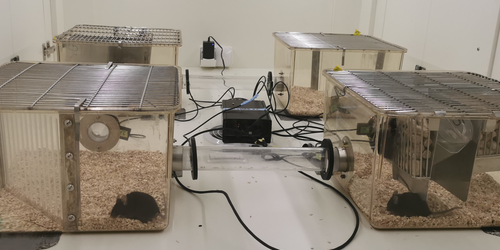A Collective-Behavior Model for Mice
From flocking birds to nesting mice, groups of animals display diverse forms of coordinated motion. Over the past few decades, scientists have developed many models capable of reproducing aspects of this collective behavior, which emerges from dynamical interactions among the creatures. But none of these models could replicate both the static and dynamical properties of the systems they described, says Xiaowen Chen of the École Normale Supérieure in France. Chen and her colleagues have now developed a model that can [1].
The team developed an inference model, which is a model that uses data analysis to infer the statistical parameters of a system. The data came from the movements of a single-sex group of 15 mice within a mouse-burrow-like habitat. The habitat contained four chambers—two filled with food—and experienced a 24-hour day-night cycle for a total of 10 days. Radio-frequency chips implanted in the mice transmitted the positions of the mice at fixed spatial landmarks.
From this information, the model inferred the static distributions of the system, such as how many mice were in a box at a given time. It then learned the dynamical features of the system, such as the distribution of the lengths of time during which the mice were motionless. This second step, which the team achieved by enforcing a commonly used assumption in statistical mechanics called the fluctuation–dissipation relation, is where previous models fell short. Chen says that her team’s method of relating the static and dynamical features of a large interacting system is not only good for describing the collective motion of animals, but could be applied in many more settings, such as biological tissues and networks of neurons.
–Katherine Wright
Katherine Wright is the Deputy Editor of Physics Magazine.
References
- X. Chen et al., “Generalized Glauber dynamics for inference in biology,” Phys. Rev. X 13, 041053 (2023).




